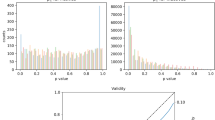Abstract
We present a method for interpretation of conformal prediction models. The discrete gradient of the largest p-value is calculated with respect to object space. A criterion is applied to identify the most important component of the gradient and the corresponding part of the object is visualized.
The method is exemplified with data from drug discovery relating chemical compounds to mutagenicity. Furthermore, a comparison is made to already established important subgraphs with respect to mutagenicity and this initial assessment shows very useful results with respect to interpretation of a conformal predictor.
Access this chapter
Tax calculation will be finalised at checkout
Purchases are for personal use only
Preview
Unable to display preview. Download preview PDF.
Similar content being viewed by others
References
Daylight Theory: SMARTS - A Language for Describing Molecular Patterns. http://www.daylight.com/dayhtml/doc/theory/theory.smarts.html (accessed January 13, 2015)
Openeye Scientific Software. http://www.eyesopen.com (accessed August 30, 2014)
Ames, B.N., Lee, F.D., Durston, W.E.: An improved bacterial test system for the detection and classification of mutagens and carcinogens. Proceedings of the National Academy of Sciences 70(3), 782–786 (1973). http://www.pnas.org/content/70/3/782.abstract
Carlsson, L., Helgee, E.A., Boyer, S.: Interpretation of nonlinear qsar models applied to ames mutagenicity data. Journal of Chemical Information and Modeling 49(11), 2551–2558 (2009). http://dx.doi.org/10.1021/ci9002206, pMID: 19824682
Chang, C.C., Lin, C.J.: LIBSVM: a library for support vector machines (2001), software available at http://www.csie.ntu.edu.tw/~cjlin/libsvm
Eklund, M., Norinder, U., Boyer, S., Carlsson, L.: The application of conformal prediction to the drug discovery process. Annals of Mathematics and Artificial Intelligence, pp. 1–16 (2013). http://dx.doi.org/10.1007/s10472-013-9378-2
Faulon, J.L., Churchwell, C.J.: Signature Molecular Descriptor. 2. Enumerating Molecules from Their Extended Valence Sequences. J. Chem. Inf. Comput. Sci. 43, 721–734 (2003)
Faulon, J.L., Visco, D.P.J., Pophale, R.S.: Signature Molecular Descriptor. 1. Using Extended Valence Sequences in QSAR and QSPR Studies. J. Chem. Inf. Comput. Sci. 43, 707–720 (2003)
Grover, M., Singh, B., Bakshi, M., Singh, S.: Quantitative structure-property relationships in pharmaceutical research. Pharm. Sci. & Tech. Today 3(1), 28–35 (2000)
Kazius, J., McGuire, R., Bursi, R.: Derivation and Validation of Toxicophores for Mutagenicity Prediction. J. Med. Chem 48, 312–320 (2005)
Lewis, R.A.: A General Method for Exploiting QSAR Models in Lead Optimization. J. Med. Chem. 48(5), 1638–1648 (2005)
Shafer, G., Vovk, V.: A tutorial on conformal prediction. Journal of Machine Learning Research 9, 371–421 (2008). http://www.jmlr.org/papers/volume9/shafer08a/shafer08a.pdf
Spjuth, O., Eklund, M., Ahlberg Helgee, E., Boyer, S., Carlsson, L.: Integrated decision support for assessing chemical liabilities. J. Chem. Inf. Model. 51(8), 1840–1847 (2011)
Steinbeck, C., Han, Y., Kuhn, S., Horlacher, O., Luttmann, E., Willighagen, E.: The chemistry development kit (cdk) an open-source java library for chemo- and bioinformatics. J. Chem. Inf. Comput. Sci. 43(2), 493–500 (2003). http://dx.doi.org/10.1021/ci025584y, pMID: 12653513
Stålring, J., Almeida, P.R., Carlsson, L., Helgee Ahlberg, E., Hasselgren, C., Boyer, S.: Localized heuristic inverse quantitative structure activity relationship with bulk descriptors using numerical gradients. Journal of Chemical Information and Modeling 53(8), 2001–2017 (2013). http://dx.doi.org/10.1021/ci400281y, pMID: 23845139
Vovk, V., Gammerman, A., Shafer, G.: Algorithmic Learning in a Random World. Springer-Verlag New York Inc., Secaucus (2005)
Young, S., Gombar, V., Emptage, M., Cariello, N., Lambert, C.: Mixture De-Convolution and Analysis of Ames Mutagenicity Data. Chemometrics and Intelligent Laboratory Systems 60, 5–11 (2002)
Author information
Authors and Affiliations
Corresponding author
Editor information
Editors and Affiliations
Rights and permissions
Copyright information
© 2015 Springer International Publishing Switzerland
About this paper
Cite this paper
Ahlberg, E., Spjuth, O., Hasselgren, C., Carlsson, L. (2015). Interpretation of Conformal Prediction Classification Models. In: Gammerman, A., Vovk, V., Papadopoulos, H. (eds) Statistical Learning and Data Sciences. SLDS 2015. Lecture Notes in Computer Science(), vol 9047. Springer, Cham. https://doi.org/10.1007/978-3-319-17091-6_27
Download citation
DOI: https://doi.org/10.1007/978-3-319-17091-6_27
Published:
Publisher Name: Springer, Cham
Print ISBN: 978-3-319-17090-9
Online ISBN: 978-3-319-17091-6
eBook Packages: Computer ScienceComputer Science (R0)



